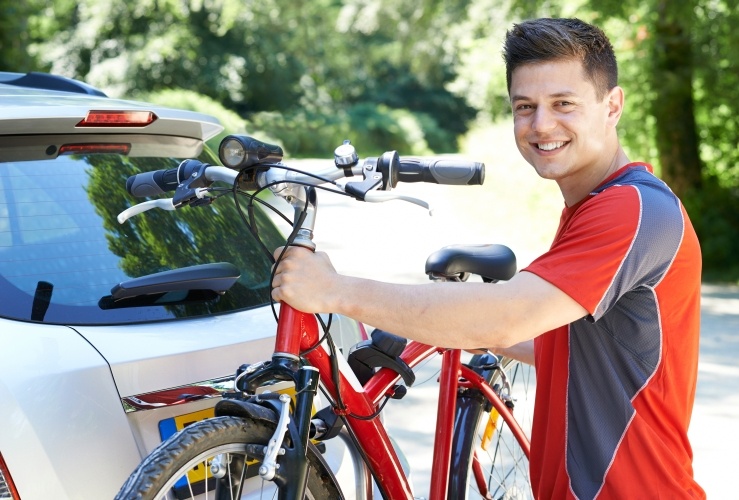Transporting your bike on or inside your car can open up a vast number of on and off-road cycling routes outside your local area. Here’s a quick guide to choosing the right bike rack for you.

For those with large SUVs or space wagons, transporting a bicycle in the cabin can be fairly straightforward, enabling you to enjoy a bike ride away from your home. But even if your vehicle has the required space, it will severely limit your ability to carry passengers – and on the return trip, it could well mean your muddy bike tyres dirty the interior. In such circumstances a bike rack can be very useful.
Naturally, for smaller cars and vehicles, a bike rack is probably the only way to carry your bike, unless you remove the front wheel and place it inside – and even then your bike may not fit and could inhibit movement in the cabin.
There are three common types of bike rack, each of which lets you securely attach your bike to the exterior of your car. These are the boot-mounted, roof-mounted and tow-bar (or hitch) mounted varieties.
Boot mounted rack
- Make sure all the straps are attached to the rack and that the straps are more or less even in length. The metal and rubber hooks should be tightly fitted to the top, sides and bottom of your boot lid. However, bear in mind that once you lift your bike onto the rack, the resulting weight may mean you need to further tighten the straps.
- Place the horizontal bar of your bike’s frame into the grooves of the horizontal bars of the rack. The bike's weight should be balanced evenly on the rack.
- Fix the straps on the rack around the top tube of your bike’s frame, securing the bike to the rack. These straps may be hook-and-loop or Velcro – depending on the brand you buy.
- Carefully inspect the bike and straps, ensuring the bike is secured as tightly as possible.
Roof mounted rack
- Some racks require you to remove the bike's front wheel before you can mount it. If there is no large curved "hook" at the front of the rack, but instead a t-shaped fitting or a cylindrical cross-bar, you will need to take the front wheel off.
- Place the bike into the 'tray' on top of the car, front wheel forward. If the front wheel needs to be removed with your type of rack, set the bike's fork into the front apparatus and use the clamp to secure it. For racks that do not require front wheel removal, pull on the curved front hook and wrap it around the front tyre.
- Wrap the hook-and-eye strap at the rear around the back tyre and tighten securely.
Hitch (tow-bar)-mounted rack
- There are basically two types of tow bar mounted racks. Some feature a tray near the bottom in which you set the bike; others work by hanging the bike near the rack top and being strapped into place.
- Place the bike’s tyres into the tray at the rack's bottom, or set the horizontal tube into the rests near the rack's top. Ensure weight is distributed evenly.
- For racks with groove rests at the top, wrap the hook-and-eye/rubber straps around the bike’s frame.
Which rack is best for you?
Each rack type has pros and cons. Depending on which rack you buy, the length, width or height of your car will be changed, so you should take extra care when manoeuvring. Some drivers have even entered their garage with their bike still mounted on their roof!
The roof rack will not prevent access to your boot, as with boot and tow-bar mounted options. However, you will need to be tall enough and fit enough to place the bike on the roof.
Final option: place it inside your car
If you're worried about bike security or increased fuel consumption due to the drag from the bike rack – and if you have enough space – you can always remove the front wheel and place the bike in your boot, or over any fold-down rear seats.
Tip: Place the gear system face-up so you don’t get grease on your interior and so you don’t alter the gear apparatus.
One of the advantages of bicycles is that they do not need insurance. However, that doesn’t mean it's not a good idea. The UK bicycle market is vast, making bicycles very attractive to thieves. Indeed, more than 300,000 bicycles are stolen every year in the UK, according to ONS data.




